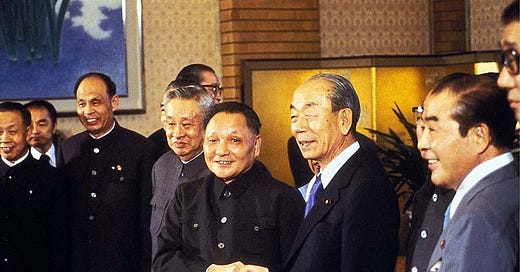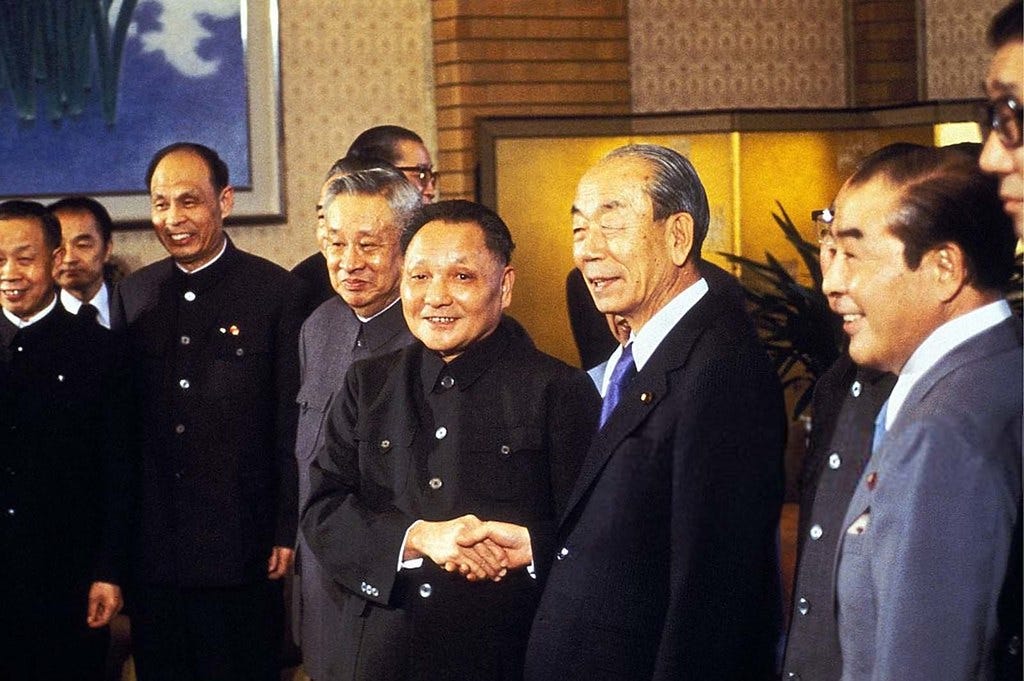When China and Japan were friends
In October 1978, Chinese leader Deng Xiaoping traveled to Japan to sign the Treaty of Peace and Friendship between the two countries. The long-term goal of the treaty was to strengthen and stabilize the relationship between China and Japan. The short term goal was geopolitical: it was important for China to receive Japan’s support at a time when the Vietnamese (following the US withdrawal) were deepening an alliance with the Soviet Union (China’s main enemy, which was expanding its military presence in Vietnam), and when Hanoi was sending signals that it was planning an invasion of Cambodia (an ally of China) to build a hegemonic Indochina state (Vietnam plus Laos and Cambodia under Hanoi’s leadership) in Southeast Asia. To counter Vietnamese aspirations, Deng Xiaoping made trips and signed treaties with the US, Southeast Asian countries and Japan.
The visit to Japan was arguably the most special. Japan has been the country that has most influenced China’s economic model (for more details, read Joe Studwell’s How Asia Works). But what is striking about the visit is the spirit of reconciliation and friendship of Deng’s trip to Japan, in contrast to a past of Japanese invasion and war between the two countries, and the heightened tensions that have occurred once China has risen as Asia’s leading power, overtaking Japan.
The atmosphere when Deng visited Japan in 1978 was special, but it is also proof of the possibility of good and productive relations between China and Japan. Deng opened the door to something unusual in the history of China-Japan relations, as Ezra Vogel recalls in his biography of Deng Xiaoping:
In the 2,200 years of contact between China and its island neighbor, Deng was the first Chinese leader to set foot in Japan. He was also the first to meet the emperor of Japan.
Deng had experience in dealing with Japanese visitors to China prior to his visit in 1978. These previous encounters were also good and expressed common sentiments of appreciation of the ties and contributions between the two nations:
In 1974 and 1975, when Deng was responsible for meeting high-level foreign leaders, he saw far more visitors from Japan than from any other country. Through his personal interactions with these Japanese representatives, he had come to understand that the Japanese people, from all levels of society, shared an affinity for Chinese culture. Again and again, Japanese hosts expressed to Deng their gratitude to China as the wellspring of Japanese culture - their Buddhism, their written language, their art, and their architecture, especially in the cities that Japanese embraced as the heart of old Japan, Nara and Kyoto.
When Deng traveled to Japan, in addition to geopolitical goals, there were also economic goals of learning from Japan’s modernization and technological superiority. After World War II, Japan’s growth was surprisingly robust, and it was an example to the rest of Asia and the developing world:
For Deng, another key to modernization was what he called “management”, i.e., productivity and attention to quality. He was glad that this mentality was also applied in the diplomatic field:
When in Japan, Deng had a full schedule. Deng, the ex-military commander who believed in strict discipline, could not help but be impressed by the care his hosts took in arranging his visit: they paid as much attention to detail as quality-control engineers in a Japanese factory.
The meeting between Deng and Japanese Prime Minister Fukuda was extremely charming and Deng engaged in friendly scenes of informality to strengthen human ties:
After the ceremony, when he went to meet Prime Minister Fukuda, Deng took out a pack of Panda cigarettes and offered cigarettes to everyone, which inmediately lightened the mood. Deng said, “For years I have been looking for an opportunity to visit Japan, and finally I can realize it. I am very happy to have the chance to get to know Prime Minister Fukuda.” Fukuda replied, “The unusual relations between China and Japan that have existed for almost a century have come to an end. The purpose of this treaty is to establish parmanent peaceful and firendly relations. The treaty is result of decisions by Vice Premier Deng Xiaoping.” When Fukuda said that he knew China only from before the war and hoped some day to have a chance to visit China again, Deng immediately replied, “On behalf of the Chinese government I invite you to visit China at a time convenient to you.” His host accepted on the spot, saying, “I will definitely visit China.” After Fukuda spoke of strengthening their relationship, Deng laughingly said, “It’s really amazing for Japan to take such a poor person [China] as a friend.” After Sonoda and Huang Hua signed and exchanged the official documents, Deng unexpectedly gave a big hug to Fukuda, who looked nonplussed but quickly recovered and took it as a sign of goodwill.
Throughout the trip, there were constant mentions by Deng of the two-way contributions between China and Japan. Japan had built its culture from multiple Chinese sources, now it was China’s turn to learn from Japan economically and technologically:
When Deng was touring the Nijō Castle in Kyoto, his host said, “All the culture you see here was introduced by our ancestors who learned it from China and then gradually adapted it in our own unique way.” Deng immediately responded, “Now our positions [as student and teacher] are reversed.”
The joyful mood was not only on the Chinese side. Former Japanese Prime Minister Tanaka Kakuei said after the signing of the treaty:
that the union of China and Japan in the Treaty of Peace and Friendship was the best thing that had happened since the Meiji Restoration.
Deng also attended unorthodox activities for a communist leader, such as attending a free press conference (also surprising in comparison to today’s China):
In China Deng had never held a press conference, but on that day he became the first Chinese Communist leader to hold a Western-style press conference in any location. Some four hundred reporters attended at the Japan Press Center.
Finally, Deng spent a lot of time visiting factories, local governments, trains… To understand by experience the Japanese development. But his curiosity (as in many other trips he made) went beyond the strictly economic or political:
At a hotel in the Kansai area, Deng walked by a room with festivities and caught a glimpse of a woman in a beautiful white dress. When he asked what was going on and learned that a wedding celebration was in progress, he asked if he could see, and the happy couple, pleased that their wedding had become an international news story, happily posed for pictures with Deng to great amusement of the onlookers.




